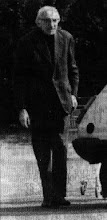Eric Santner has drawn attention to what he takes to be a crucial aspect of Franz Rosenzweig’s The Star of Redemption. For Rosenzweig, he argues, the elaboration of the predicative being of the Other, the ‘whatness’ of the Other, functions according to the pleasure principle: thus, in relation to the one loved, ‘each predicate “discharges” some of the tension sustaining my effort to locate the essence of the beloved’. However, at the heart of this effort ‘there is the “pulse” of an encounter with the Other in his or her sheer, “tautological” presence—his or her “ipseity”—beyond predicative being, beyond the “whatness” of essences’. (One may be reminded here of Wittgenstein’s discussion of games and the essence of language.) Freud calls this tautological ‘essence’ of the Other the Thing (das Ding). The Thing is not a thing as such, but a breach in the chain of being. Rosenzweig sees in the emergence of the Thing, thus understood, the birth of the metaethical self. This emergence is, for Santner, and other commentators, such as Slavoj Zizek and Kenneth Reinhard, correlative to what Freud understood as the emergence of Triebschicksal, the drive destiny that separates human existence from that of other creatures. We are the only creatures capable of reflecting on our deaths, and as a result we enjoy an excess beyond that of other creatures. Eagleton summarises Santner’s position as follows: ‘because this reflection intensifies our sense of mortality, we become more purely animal than [other creatures] are’.
Freud distinguishes between instinct and drive. The body of the instincts is a body of need, while the body of the drives is a body of want, lack, or requirement. Need refers to what is necessary for self-preservation. We need to eat and to breathe in order to survive. Requirement refers to a necessity that is not a matter of survival. The body of need and the body of drive are both real insofar as the source of them is in the body, but whereas need involves the inside of the body (stomach, lungs, intestines and so on) drive involves the surface of the body and its erogenous openings, its rims. The shift is from breath to voice.
My suggestion (and it is merely a suggestion, not a position, not a thesis) is that one can see, perhaps, this shift at work in some of Olson’s writing, a shift evident in a certain torsion of the text, of its syntax and predicative organisation. One may at times become aware of a stain or anamorphosis in the writing, a breach not infrequently inherent in, or arising from, repetition induced by a sense, not of place, but death. I would be inclined to say that at such moments of insistence something similar to Barthes’s punctum appears, or can be experienced, in the studium of Olson’s otherwise intelligible and differently explicable purposes. One is seized by a remainder or left-over that Rosenzweig called a surplus of the real within reality. It may be that one comes to find oneself in a realm between two deaths.
Subscribe to:
Post Comments (Atom)



No comments:
Post a Comment